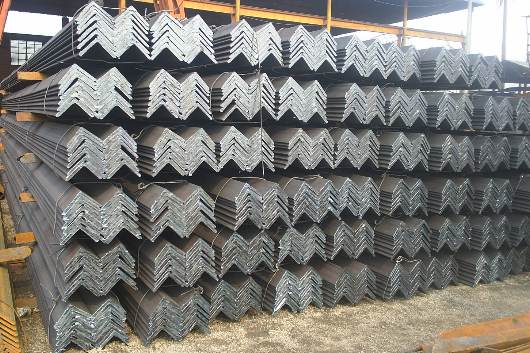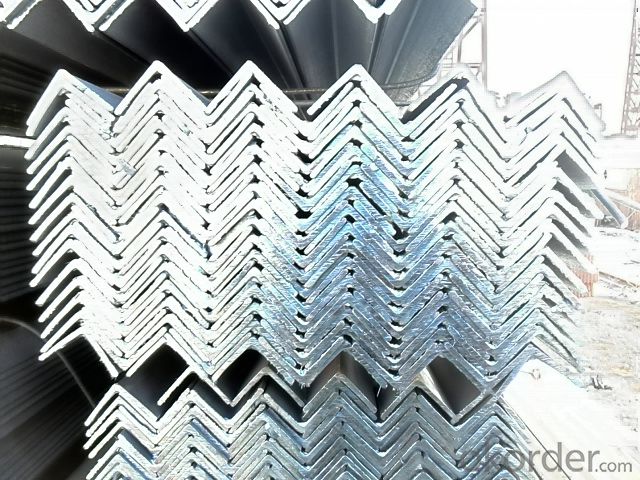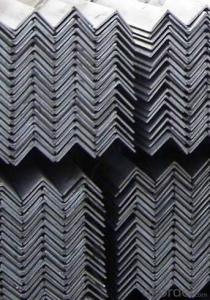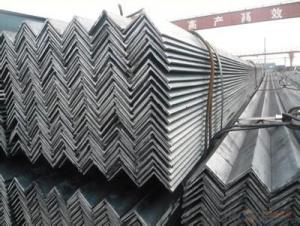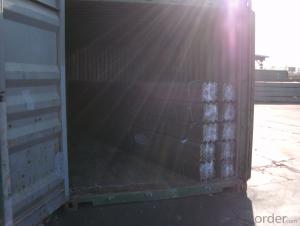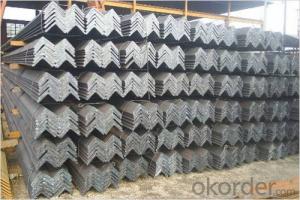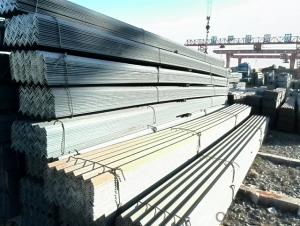Hot Rolled Equal Angle Steel with Grade GB-Q235
- Loading Port:
- Tianjin
- Payment Terms:
- TT OR LC
- Min Order Qty:
- 25 m.t.
- Supply Capability:
- 10000 m.t./month
OKorder Service Pledge
OKorder Financial Service
You Might Also Like
Product Description:
OKorder is offering high quality Hot Rolled Equal Angle Steel at great prices with worldwide shipping. Our supplier is a world-class manufacturer of steel, with our products utilized the world over. OKorder annually supplies products to European, North American and Asian markets. We provide quotations within 24 hours of receiving an inquiry and guarantee competitive prices.
Product Applications:
Hot Rolled Equal Angle Steels are ideal for structural applications and are widely used in the construction of buildings and bridges, and the manufacturing, petrochemical, and transportation industries.
Product Advantages:
OKorder's Hot Rolled Equal Angle Steels are durable, strong, and resist corrosion.
Main Product Features:
· Premium quality
· Prompt delivery & seaworthy packing (30 days after receiving deposit)
· Corrosion resistance
· Can be recycled and reused
· Mill test certification
· Professional Service
· Competitive pricing
Product Specifications:
Manufacture: Hot rolled
Grade: Q195 – 235
Certificates: ISO, SGS, BV, CIQ
Length: 6m – 12m, as per customer request
Packaging: Export packing, nude packing, bundled
EQUAL ANGLES SIZES |
| ||
a(mm) | a1(mm) | thickness(mm) | length |
25 | 25 | 2.5---3.0 | 6M/12M |
30 | 30 | 2.5---4.0 | 6M/12M |
38 | 38 | 2.5 | 6M/12M |
38 | 38 | 3.0---5.0 | 6M/12M |
40 | 40 | 3.0---6.0 | 6M/12M |
50 | 50 | 3 | 6M/12M |
50 | 50 | 3.7---6.0 | 6M/9M/12M |
60 | 60 | 5.0---6.0 | 6M/9M/12M |
63 | 63 | 6.0---8.0 | 6M/9M/12M |
65 | 65 | 5.0---8.0 | 6M/9M/12M |
70 | 70 | 6.0---7.0 | 6M/9M/12M |
75 | 75 | 5.0---10.0 | 6M/9M/12M |
80 | 80 | 6.0---10.0 | 6M/9M/12M |
90 | 90 | 6.0---10.0 | 6M/9M/12M |
100 | 100 | 6.0---12.0 | 6M/9M/12M |
120 | 120 | 8.0-12.0 | 6M/9M/12M |
125 | 125 | 8.0---12.0 | 6M/9M/12M |
130 | 130 | 9.0-12.0 | 6M/9M/12M |
140 | 140 | 10.0-16.0 | 6M/9M/12M |
150 | 150 | 10---15 | 6M/9M/12M |
160 | 160 | 10---16 | 6M/9M/12M |
180 | 180 | 12---18 | 6M/9M/12M |
200 | 200 | 14---20 | 6M/9M/12M |
FAQ:
Q1: Why buy Materials & Equipment from OKorder.com?
A1: All products offered byOKorder.com are carefully selected from China's most reliable manufacturing enterprises. Through its ISO certifications, OKorder.com adheres to the highest standards and a commitment to supply chain safety and customer satisfaction.
Q2: What makes stainless steel stainless?
A2: Stainless steel must contain at least 10.5 % chromium. It is this element that reacts with the oxygen in the air to form a complex chrome-oxide surface layer that is invisible but strong enough to prevent further oxygen from "staining" (rusting) the surface. Higher levels of chromium and the addition of other alloying elements such as nickel and molybdenum enhance this surface layer and improve the corrosion resistance of the stainless material.
Q3: Can stainless steel rust?
A3: Stainless does not "rust" as you think of regular steel rusting with a red oxide on the surface that flakes off. If you see red rust it is probably due to some iron particles that have contaminated the surface of the stainless steel and it is these iron particles that are rusting. Look at the source of the rusting and see if you can remove it from the surface.
Images:
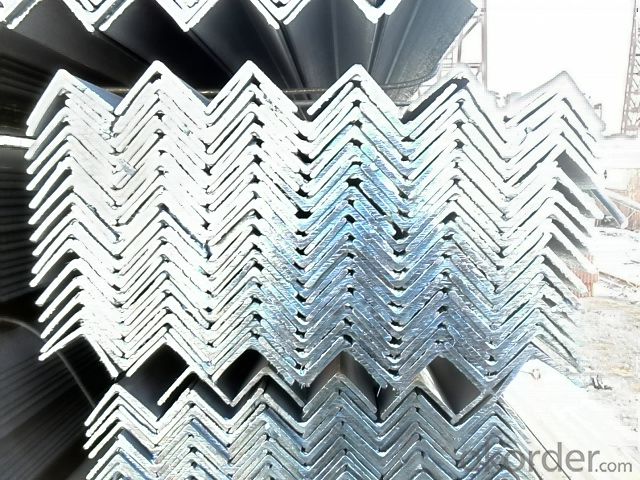

- Q: How do you straighten a bent steel angle?
- To straighten a bent steel angle, you can use a combination of manual force and mechanical aids. First, secure the angle in a vice or clamp it to a sturdy surface. Then, gently apply pressure in the opposite direction of the bend using a mallet or hammer. For more complex bends, you may need to use a hydraulic press or a bending machine. It is important to apply gradual force and check the angle's alignment frequently to avoid over-straightening or damaging the steel.
- Q: How do you calculate the moment of resistance for a steel angle?
- When calculating the moment of resistance for a steel angle, one must take into account the properties of the angle section and its dimensions. The moment of resistance measures the angle's ability to resist bending. The moment of resistance can be calculated using the formula: Moment of Resistance = Plastic Section Modulus multiplied by Yield Strength of Steel The plastic section modulus can be determined using the following formula: Plastic Section Modulus = (Width multiplied by Thickness squared) divided by 6 In this equation, the width refers to the distance between the outer edges of the angle, while the thickness refers to the thickness of the angle section. The yield strength of the steel is a material property that can be obtained from its specification or reference material. It represents the maximum stress the steel can endure without experiencing permanent deformation. By substituting the values of the plastic section modulus and the yield strength of the steel into the formula for the moment of resistance, one can calculate the value. It is important to note that the dimensions used in the calculations should be in consistent units, such as millimeters or inches, depending on the units used for the yield strength value. This calculation provides an estimation of the moment of resistance for a steel angle and is valuable in structural engineering applications for determining the angle section's capacity under bending loads.
- Q: Where can steel angles be purchased?
- Steel angles can be purchased from various sources, including steel suppliers, metal fabrication companies, hardware stores, and online marketplaces such as Amazon or Alibaba.
- Q: Can steel angles be used in solar panel installations?
- Yes, steel angles can be used in solar panel installations. They provide structural support and can be used to mount solar panels on roofs or other surfaces.
- Q: Can steel angles be used in the construction of sports stadiums?
- Yes, steel angles can be used in the construction of sports stadiums. Steel angles are versatile structural elements that can be used to support heavy loads and provide stability in large structures like sports stadiums. They are commonly used in the construction industry for various applications, including framing, support columns, and bracing systems. Steel angles offer excellent strength and durability, making them suitable for withstanding the dynamic forces and heavy loads experienced in sports stadiums. Additionally, steel angles can be easily fabricated and customized to fit the specific design and structural requirements of the stadium, offering flexibility in construction. Overall, steel angles are an ideal choice for the construction of sports stadiums due to their strength, versatility, and ability to withstand the unique demands of such large-scale structures.
- Q: Are steel angles resistant to pests and insects?
- Steel angles are not inherently resistant to pests and insects. While steel itself is not an attractive material for pests and insects, steel angles can still be susceptible to infestation or damage if there are openings or gaps where pests can gain access. Additionally, pests can still cause damage to other materials in the vicinity of the steel angles, which may indirectly affect their overall integrity. Therefore, it is important to ensure that proper pest control measures are in place and that any potential entry points or vulnerabilities are addressed to minimize the risk of pest infestation or damage to steel angles.
- Q: How do steel angles perform under extreme temperatures?
- Steel angles typically perform well under extreme temperatures. Steel is known for its high thermal conductivity, which means it can quickly absorb and distribute heat. This property helps steel angles to withstand extreme temperatures without significant deformation or failure. However, it is important to note that the specific performance of steel angles under extreme temperatures can vary depending on factors such as the alloy composition and heat treatment of the steel. In some cases, steel angles may experience reduced strength or become more susceptible to corrosion at extremely high temperatures. It is recommended to consult with a materials engineer or refer to the manufacturer's specifications to determine the specific performance of steel angles under the desired extreme temperature conditions.
- Q: How do you calculate the section modulus of a steel angle?
- To calculate the section modulus of a steel angle, you need to know the dimensions and properties of the angle. The section modulus is a measure of the strength of a structural member and is used to determine its resistance to bending. The formula to calculate the section modulus of a steel angle is: Section Modulus (Z) = (Width of the angle * Height of the angle^2) / 6 In this formula, the width of the angle refers to the distance between the two legs, while the height of the angle is the length of one leg. The section modulus is typically expressed in cubic inches or cubic centimeters. To calculate the section modulus, first measure the width and height of the angle. Then substitute these values into the formula to find the section modulus. This value will give you an indication of the strength and stiffness of the steel angle, which can be used in structural design and analysis.
- Q: What is the difference between hot-rolled and cold-rolled steel angles?
- Two distinct methods, hot-rolling and cold-rolling, are employed in the production of steel angles, resulting in varying characteristics. Hot-rolling involves heating a steel billet or ingot to a high temperature and subsequently passing it through a series of rollers. This process allows for the metal to be shaped and formed while it retains its malleability and pliability. Consequently, hot-rolled steel angles possess a coarser surface finish and less precise dimensions when compared to their cold-rolled counterparts. However, their strength and durability are generally superior, rendering them appropriate for structural applications necessitating high strength and load-bearing capacity. Conversely, cold-rolling entails passing hot-rolled steel through a sequence of rollers at room temperature. This procedure not only refines the dimensions and surface finish of the steel angles but also enhances their strength and hardness. Cold-rolled angles exhibit a smoother surface finish and more accurate dimensions, making them ideal for applications requiring precise fitting or a polished appearance. They are commonly employed in architectural and decorative endeavors, as well as in industries where aesthetics and precision are paramount. To summarize, the primary disparities between hot-rolled and cold-rolled steel angles lie in their manufacturing processes, surface finishes, dimensional accuracy, and applications. Hot-rolled angles are stronger and rougher, rendering them suitable for structural purposes, whereas cold-rolled angles possess a smoother finish and precise dimensions, making them more appropriate for decorative and architectural applications.
- Q: How do you calculate the torsional capacity of a steel angle?
- To calculate the torsional capacity of a steel angle, you need to consider the material properties and dimensions of the angle. The torsional capacity refers to the maximum amount of torque or twisting force that the angle can withstand without experiencing significant deformation or failure. The torsional capacity can be determined using the following steps: 1. Determine the cross-sectional properties: Measure the dimensions of the steel angle, including the thickness, width, and length. Calculate the area moment of inertia (I) and the polar moment of inertia (J) of the cross-section. These properties provide information about the resistance of the angle to torsional forces. 2. Determine the material properties: Obtain the material properties of the steel angle, such as the yield strength (σy) and the ultimate strength (σu). These values indicate the maximum stress that the material can withstand before permanent deformation or failure occurs. 3. Calculate the torsional stress: Using the applied torque (T), calculate the torsional stress (τ) on the angle. Torsional stress is the torque divided by the polar moment of inertia (τ = T / J). This calculation determines the amount of twisting force experienced by the angle. 4. Determine the safety factor: Divide the yield strength of the material by the calculated torsional stress (SF = σy / τ). The safety factor represents the ratio of the maximum stress that the angle can withstand (yield strength) to the actual stress it experiences. A higher safety factor indicates a greater margin of safety. 5. Compare the safety factor to a desired value: Depending on the specific application and design requirements, a minimum safety factor may be specified. If the calculated safety factor is below the desired value, it indicates that the angle is not suitable for the intended torsional load and a different angle or design modification may be necessary. It is important to note that these calculations provide an estimation of the torsional capacity, and other factors such as the presence of holes, welds, or other geometric irregularities can affect the actual torsional behavior of the angle. Therefore, it is recommended to consult relevant design codes or professional engineering resources for detailed calculations and recommendations specific to your application.
Send your message to us
Hot Rolled Equal Angle Steel with Grade GB-Q235
- Loading Port:
- Tianjin
- Payment Terms:
- TT OR LC
- Min Order Qty:
- 25 m.t.
- Supply Capability:
- 10000 m.t./month
OKorder Service Pledge
OKorder Financial Service
Similar products
Hot products
Hot Searches
Related keywords




